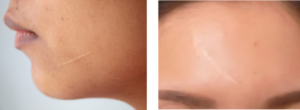Face & Body Scar Camouflage




Scars 101
What Are Scars?
Scarring is a natural part of the body’s healing process after an injury. When the deeper layers of the skin are damaged (the dermis) – a scar will be produced as part of the wound-healing cascade. The body repairs the wound by increasing production of collagen at the wound site. The fibrous tissue that forms over the wound also protects it from further injury.
Scars produce a structural change in the skin – both in the skin’s features, color and architecture. Superficial wounding of the skin in the surface layer (the epidermis), will not produce a scar. When a wound has healed, the resulting tissue covering the wound is a scar. The scar will continue to change in texture and appearance as new collagen is formed, and the blood supply returns to a more normal state. This can take from one to two years. Scars will fade and improve gradually following an injury to the skin, however, there will always be some visible evidence of the trauma, and hair follicles will not grow back.
How Does a Scar Form?
The scar that you see on the surface of the skin is the result of a complex process the skin goes through as it recovers from damage. There are many factors that affect how a wound heals, and the way the wound heals affects how the scar will end up looking in the long run. How skin heals and scars varies from person to person, but it also depends on how you care for the wound before the scar is done forming.
The skin goes through three stages of repair before you see a scar. In the first stage, there’s swelling, redness, and some tenderness or pain as a scab begins to form. During the next stage, new skin tissue forms underneath the scab. The final stage involves rebuilding and reforming the outer and inner layers of skin.
What is Medical Scar Camouflage?
Scar Camouflage tattoos also known as paramedical tattoos, are a highly specialized artistry process that camouflages skin irregularities or loss of pigment, by implanting flesh tone pigments into those areas. These pigments are tattooed into the scar or blemish by implanting washes of color – or hundreds of micro-sized dots (mimicking the pixels in digital photography). The layering of these tiny dots or washes of color, can help to visually blend the scar into the healthy surrounding skin.
Overview of Scars That Can Be Beautifully Camouflaged with Paramedical Tattooing
Scars are a natural part of life, but they don’t have to define your skin’s appearance. With the power of paramedical tattooing, various types of scars can be skillfully camouflaged, restoring both confidence and comfort. Here’s a closer look at the types of scars that can benefit from this transformative technique:
Hypopigmented Scars: Scars that have lost their pigment can be restored by tattooing to match the surrounding skin, helping to create a natural, harmonious appearance.
Surgical Scars: Whether from a plastic surgery procedure, mastectomy, or any other medical surgery, paramedical tattooing can effectively blend surgical scars with your natural skin tone, creating a seamless look.
C-Section; Tummy Tuck & Breast Surgery Scars: Whether from a cesarean section, tummy tuck or breast surgery, scars from these common procedures can be skillfully camouflaged, leaving you with smoother, more balanced skin.
Trauma Scars: Scars from accidents, dog bites and some burns can be blended into the surrounding skin matching your natural skin tone.
Cosmetic Scars – Stretch Marks: Stretch marks from pregnancy, rapid weight changes, or growth spurts can be treated with inkless tattoo techniques or light pigment washes, helping them fade into the skin and become much less noticeable.
Self-Harm Scars: For those with self-inflicted scars, paramedical tattooing can match the skin tone, reducing the visibility of these marks and offering a renewed sense of confidence.
Although a tattoo camouflage treatment cannot completely “erase” a scar, it can effectively conceal or blend the scar so seamlessly that it becomes virtually invisible to the naked eye. Additionally, the results of scar camouflage treatments are long-lasting, often lasting for many years, helping you feel more confident in your skin.
Our Paramedical Scar Services
We offer semi-permanent medical camouflage options for light-toned Facial and Body Scars resulting from Surgery or Accidents. These are referred to as “Hypo-pigmented Scars”.
Please Note: These are scars that look lighter than the surrounding skin.
See Example:
Flat Hypo-pigmented Scars
Flat hypo-pigmented scars are flat scars that become “lighter” than the surrounding skin, due to the absence of normal amounts of melanin (the chemical that gives skin its color). Loss of melanin during the wounding process is a common occurrence. In some cases, the melanin can be stimulated through clinical intervention, and prompted to regenerate.
For all scar camouflage services:
⦁ Scars must be at least one year old
⦁ Scars cannot be raised or lumpy
Treatments Available Include:
- Face lift scars
- Lip scars
- Tummy tuck / belly button scars
- Breast surgery scars
- Mastectomy scars
- Mohs surgery scars
- Skin grafts
- Accidents
- Hair transplant scars
Cosmetic Corrective Services
Stretch Mark Camouflage Treatments are available using paramedical tattoos to reduce the visibility of stretch marks by blending them with the surrounding skin tone. This method involves inserting skin-toned pigments into the affected areas to mimic the missing natural skin color, making the stretch marks less noticeable. The procedure is often performed in multiple sessions to gradually build up the desired color and achieve a natural-looking result.
We also offer Inkless Stretch Mark therapies to improve the appearance of lighter stretch marks or as a pre-treatment before paramedical tattooing to enhance the final results.

Dark Scar Camouflage
Paramedical tattooing can effectively lighten and visually blend dark scars by using carefully selected pigments to neutralize excess melanin and harmonize the scar’s color with the surrounding skin. Dark scars, often resulting from post-inflammatory hyperpigmentation, surgical procedures, injuries, or burns, may stand out due to their contrast in tone.
(Examples of Dark Scars we can Treat with Medical Tattoo Camouflage)

Using paramedical tattooing, our skilled practitioner will match the natural skin undertones using custom-blended pigments, applied directly into the scar tissue. The goal is not to “cover up” the scar in the traditional tattoo sense, but rather to correct the discoloration by implanting hues that counterbalance the darkness—often involving soft flesh tones or color-corrective shades like peach, yellow, or olive, depending on the client’s skin type.
Over a series of sessions, the pigment gradually blends the scar into the surrounding skin, making it much less noticeable. This is especially useful for scars that are flat but dark in color, as light-reflecting pigment helps create the illusion of even tone and texture. Because scar tissue absorbs pigment differently than healthy skin, the process requires precision, patience, and an in-depth understanding of color theory. The results are long-lasting and natural-looking.
READY TO DISCOVER IF MEDICAL CAMOUFLAGE COULD WORK FOR YOU?
Let’s start with a consultation
Please give us a call or send us an email to schedule an initial phone consultation. Your consultation is the most important part of your Camouflage Tattoo experience.
We will ask questions, and request current photos to help us determine if you are a good candidate for scar tattooing. In some instances, we may need to see you in clinic for an in-person consult prior to scheduling a service
With over 25 years’ experience, and over 15,000 completed procedures, the Look Natural Micropigmentation Clinic is committed to delivering the highest-quality service and results.


